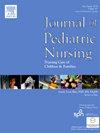Winning Poster: Implementation of an ultrasound guided PIV training program for Nurses in a Pediatric Emergency Department
IF 2.3
4区 医学
Q2 NURSING
Journal of Pediatric Nursing-Nursing Care of Children & Families
Pub Date : 2025-09-01
DOI:10.1016/j.pedn.2025.06.035
引用次数: 0
Abstract
Pediatric patients in the emergency department, especially those considered to have Difficult IV Access (DIVA), experience high levels of number of pokes, and IV-related complications (6, 7, 11, 20, 22, 25, 27). Audience: Nurses caring for DIVA patients. Synthesis: The evidence suggests that ultrasound is superior for venous access when compared to traditional methods in DIVA patients, and it can lead to a three-fold increase in the odds of first-attempt success, improved longevity of access, decreased IV-related complications, and a reduction in treatment delays (2, 3, 4, 6, 10, 12, 15, 17, 18, 21, 24, 26, 28). ED-specific USGIV training programs have been widely implemented and include didactic and precepted skills training (1, 2, 3, 9, 10, 15, 18). Evidence-based escalation algorithms are recommended to increase the effectiveness of USGIV interventions (3, 5, 13, 26). EBP Question: Does the implementation of a nurse-led USGIV training program improve first stick success, number of pokes, IV-related complications and treatment delays in a pediatric ED? Methods: The JHEBP model guided this EBP project. Implementation: A nurse-led USGIV training program was developed in collaboration with the Vascular Access Team. The training includes a didactic session, and a simulation session where learners demonstrate the ability to access a vessel on a training mold. Next, learners complete at least 20 precepted sticks in the patient care setting with an an 80 % success rate. Plan for Evaluation: Nurse adoption to practice and confidence will be assessed at program completion and after three months. Nurse competency will be monitored for first stick success rate (goal 80 %). IV related outcomes will be monitored monthly at the unit level via chart audit. Results: Two training sessions have been held and we have doubled the number of ultrasound nurses. The number of USGIV insertions has nearly quadrupled with a high first stick success rate (85 %–95 %). Conclusions: The program will continue to expand in 2025. The next steps are to collaborate with relevant stakeholders to develop and evaluate the use of an evidence-based algorithm to further guide USGIV use in the ED.
获奖海报:儿科急诊科护士超声引导PIV培训计划的实施
急诊科的儿科患者,特别是那些被认为有静脉注射困难(DIVA)的患者,会经历高水平的穿刺次数和静脉相关并发症(6,7,11,20,22,25,27)。观众:护理DIVA患者的护士。综合:有证据表明,与DIVA患者的传统方法相比,超声在静脉通路方面优于传统方法,它可以使首次尝试成功的几率增加三倍,延长通路的寿命,减少静脉相关并发症,减少治疗延误(2,3,4,6,10,12,15,17,18,21,24,26,28)。针对ed的USGIV培训方案已经广泛实施,包括说教式和指导性技能培训(1、2、3、9、10、15、18)。推荐基于证据的升级算法来提高USGIV干预措施的有效性(3,5,13,26)。EBP问题:在儿科急诊科实施护士主导的USGIV培训计划是否能提高首次注射的成功率、注射次数、静脉注射相关并发症和治疗延误?方法:采用JHEBP模型指导EBP项目。实施:与血管准入小组合作制定了护士领导的USGIV培训计划。培训包括教学会议和模拟会议,其中学习者展示了在培训模具上访问船舶的能力。接下来,学习者在病人护理环境中完成至少20个预设棒,成功率为80% %。评估计划:护士对实践的接受程度和信心将在项目完成后和三个月后进行评估。将监测护士的能力,以确定首次粘贴的成功率(目标80 %)。IV相关结果将通过图表审核每月在单位层面进行监测。结果:举办了两次培训,超声护士人数增加了一倍。USGIV插入的数量几乎翻了两番,第一棒成功率很高(85 % -95 %)。结论:该计划将在2025年继续扩大。接下来的步骤是与相关利益攸关方合作,开发和评估基于证据的算法的使用,以进一步指导USGIV在ED中的使用。
本文章由计算机程序翻译,如有差异,请以英文原文为准。
求助全文
约1分钟内获得全文
求助全文
来源期刊

Journal of Pediatric Nursing-Nursing Care of Children & Families
NURSING-PEDIATRICS
CiteScore
3.70
自引率
8.30%
发文量
291
审稿时长
65 days
期刊介绍:
Official Journal of the Society of Pediatric Nurses and the Pediatric Endocrinology Nursing Society (PENS)
The Journal of Pediatric Nursing: Nursing Care of Children and Families (JPN) is interested in publishing evidence-based practice, quality improvement, theory, and research papers on a variety of topics from US and international authors. JPN is the official journal of the Society of Pediatric Nurses and the Pediatric Endocrinology Nursing Society. Cecily L. Betz, PhD, RN, FAAN is the Founder and Editor in Chief.
Journal content covers the life span from birth to adolescence. Submissions should be pertinent to the nursing care needs of healthy and ill infants, children, and adolescents, addressing their biopsychosocial needs. JPN also features the following regular columns for which authors may submit brief papers: Hot Topics and Technology.
 求助内容:
求助内容: 应助结果提醒方式:
应助结果提醒方式:


